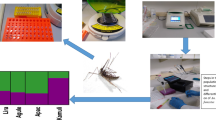Abstract
There are many species in which groups of individuals encountered in the field are known to consist of mixtures of full-sibling families. We describe a statistical technique, based on the use of random amplified polymorphic DNA-polymerase chain reaction (RAPD-PCR) markers, that allows for the estimation of the number of families contained in these groups. We test the technique on full-sibling families of the mosquito Aedes aegypti, a species that distributes its eggs among several locations. Mixtures of 10 families with 15 individuals per family were analyzed using 40 RAPD-PCR loci amplified by 5 primers. Our analysis accurately estimated the number of families. The technique was accurate when the number of families was small or when family sizes were small and variable.
Similar content being viewed by others
References
Ballinger-Crabtree ME, Black WC IV, Miller BR (1992) Use of genetic polymorphisms detected by RAPD-PCR for differentiation and identification of Aedes aegypti subspecies and populations. Am J Trop Med Hyg 47:893–901
Black WC IV, DuTeau NM, Puterka GJ, Nechols JR, Pettorini JM (1992) Use of random amplified polymorphic DNA polymerase chain reaction (RAPD-PCR) to detect DNA polymorphisms in aphids. Bull Entomol Res 82:151–159
Burke T, Bruford MW (1987) DNA fingerprinting in birds. Nature 327:149–152
Buxton PA, Hopkins GHE (1927) Researches in Polynesia and Melanesia, an account of investigations in Samoa, Tonga, the Ellice Group and the New Hebrides, in 1924 and 1925. Mem London Sch Hyg Trop Med 1:125–158
Chadee DD, Corbet PS (1991) The gonotrophic status of female Aedes aegypti (L.) overnight at the oviposition site (Diptera: Culicidae). Ann Trop Med Parasit 85:461–466
Chakraborty R, Kidd KK (1990) The utility of DNA typing in forensic work. Science 254:1735–1739
Christophers SR (1960) Aedes aegypti (L.). The yellow fever mosquito. Cambridge University Press, Cambridge
Jarne P, Delay B, Bellec C, Roizes G, Cuny G (1992) Analysis of mating systems in the schistosome-vector hermaphrodite snail Bulinus globosus by DNA fingerprinting. Heredity 68:141–146
Jeffreys AJ, Wilson V, Thein SL (1985) Hypervariable ‘minisatellite’ regions in human DNA. Nature 314:67–73
Johnson RA, Wichern DW (1982) Applied multivariate statistical analysis. Prentice-Hall, Englewood Cliffs, NJ
Kambhampati S, Black WC IV, Rai KS (1992) RAPD-PCR of mosquito species and population: techniques, statistical analysis and applications. J Med Entomol 29:939–945
Kasai K, Nakamura Y, White R (1990) Amplification of a variable number of tandem repeats (VNTR) locus (pMCT118) by the polymerase chain reaction (PCR) and its applications to forensic science. J Forensic Sci 35:1196–1200
Lynch M (1988) Estimation of relatedness by DNA fingerprinting. Mol Biol Evol 5:584–599
McCammon RB, Wenninger G (1970) The dendrograph. Kans Geol Surv Comput Contrib No. 48
Munstermann LE, Craig GB (1979) Genetics of Aedes aegypti: updating the linkage map. J Hered 70:291–296
Pemberton J, Amos B (1990) DNA fingerprinting: a new dimension. Trends Genet 60:101–103
Puterka GJ, Black WC IV, Steiner WM, Burton RL (1993) Genetic variation and phylogenetic relationships among worldwide collections of the Russian Wheat Aphid, Diuraphis noxia (Mordvilko), inferred from allozyme and RAPD-PCR markers. Heredity 70:604–618
Reeve HK, Westneat DF, Noon WA, Sherman PW, Aquadro CF (1990) DNA “fingerprinting” reveals high levels of inbreeding in colonies of the eusocial naked mole-rat. Proc Natl Acad Sci USA 87:2496–2500
Shufran KA, Black WC IV, Margolies DC (1991) DNA fingerprinting to study spatial and temporal distributions of an aphid, Schizaphis graminum (Homoptera: Aphididae). Bull Entomol Res 81:303–313
Welsh J, McClelland M (1990) Fingerprinting genomes using PCR with arbitrary primers. Nucleic Acids Res 18:7213–7218
Welsh J, Petersen CP, McClelland M (1991) Polymorphisms generated by arbitrarily primed PCR in the mouse: application to strain identification and genetic mapping. Nucleic Acids Res 19:303–306
Westneat DF (1990) Genetic parentage in the indigo bunting: a study using DNA fingerprinting. Behav Ecol Socibiol 27:67–76
Wetton JH, Royston EC, Parkin DT, Walters D (1987) Demographic study of a wild house sparrow population by DNA fingerprinting. Nature 327:147–149
Williams JK, Kubelik AR, Livak KJ, Rafalski JA, Tingey SV (1991) DNA polymorphisms amplified by arbitrary primers are useful as genetic markers. Nucleic Acids Res 18:6531–6535
Wilson EO (1971) The insect societies. Belknap Press, Cambridge, Mass
Author information
Authors and Affiliations
Additional information
Communicated by J. S. F. Barker
Rights and permissions
About this article
Cite this article
Apostol, B.L., Black, W.C., Miller, B.R. et al. Estimation of the number of full sibling families at an oviposition site using RAPD-PCR markers: applications to the mosquito Aedes aegypti . Theoret. Appl. Genetics 86, 991–1000 (1993). https://doi.org/10.1007/BF00211052
Received:
Accepted:
Issue Date:
DOI: https://doi.org/10.1007/BF00211052




